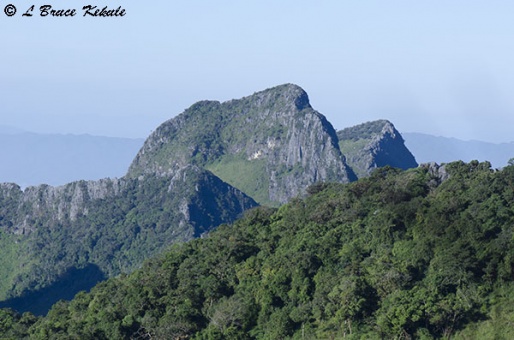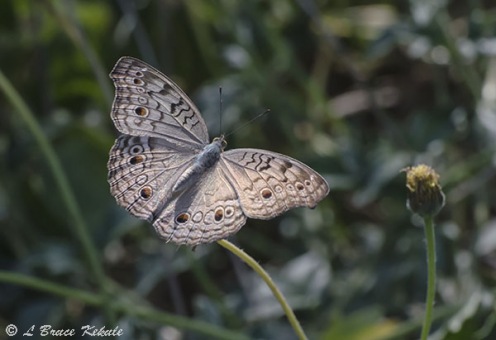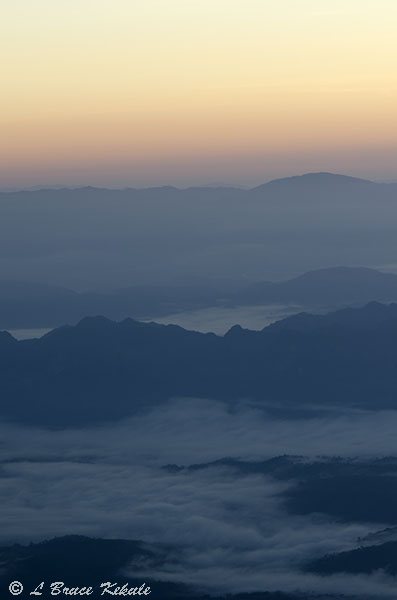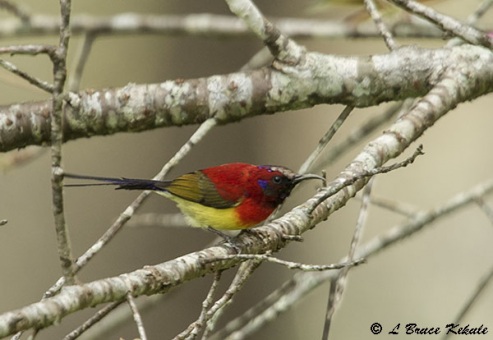Posts Tagged ‘massif’
Doi Chiang Dao: Northern limestone massif
Mountain sanctuary and protected area in Chiang Mai
Sunset taken from Doi Luang Chiang Dao at 2,226 meters.
Imagine a huge limestone karst massif with vertical cliffs towering strait up into the clouds and Doi Chiang Dao in the northern province of Chiang Mai comes to mind. This enormous horseshoe shaped mountain was formed over 200 million years ago during the mid to late Permian era.
It was a time of widespread mountain building and volcanic activity. Thailand was part of ‘Gondwanaland’ that was still attached to ‘Pangaea’, the ‘Supercontinent’.
Goral male with a winter coat up on the rocks of Doi Luang.
This colossal outcrop with the highest peak, Doi Luang, reaching some 2225 meters above sea level looks almost ‘architectural’ and is the Kingdom’s third tallest mountain after Doi Pha Hom Pok and Doi Inthanon. Doi means ‘mountain’ in Thai.
In December last year, a trip to photograph the flora and fauna of Doi Chiang Dao Wildlife Sanctuary was undertaken. Prior to that, I visited the headquarters near the famous ‘Chiang Dao cave’ and had a talk with the chief, so I could get an idea what I was about to embark on. The walking trail up to the summit of the mountain is 8.5 kilometers long and said to be pretty tough. This was an understatement!
Parrot flowers or ‘Tien nok kaew’ in Thai (Impatiens psittacina).
From the back of the mountain, some 25 kilometers west of Chiang Dao, a ranger station named ‘Denyacut’ is located where the walking trail begins. From there it is long hard climb that can be very dangerous in some places. The karst mountain still has serious run-off just after the rainy season ending in late-October.
This makes for a slippery trail and in some locations, ‘slick as an eel’ is the only thing that can be described. Every step was with great effort to keep from sliding down to what could be the end of my days.
A view of ‘three in-laws’ karst outcrops.
That first climb took me nine hours but I did take my time going real slow stopping to take pictures of flowers and the view from time to time. My guide and forest ranger named Thep Kanoo and my close friend Sawawut Sawkhamkhet plus four pack bearers accompanied me as we made our way up. I eventually arrived in the dark at 8pm and it was already getting cold.
We had a quick meal and it was straight into the tent for me. I was totally exhausted. Winter is in full swing then and the temperature dropped down to 6 degrees Celsius early the next morning. For a tropics guy like me, it was freezing but I slept fairly comfortable because of a good mountain tent and super warm sleeping bag.
A pansi butterfly near the summit.
The next morning, we all got up at 4am and had breakfast made up of some coffee, eggs and bread. There were about 100 visitors and bearers already up there, set-up in clusters around the valley close to the top. As in many of Thailand’s protected areas, noisy-people is a common occurrence.
We left the campground at 5am and climbed out to a viewpoint on the cliff face to watch the sunrise. We could see Chiang Dao town below beginning to come alive. The air was crisp and hovering then around 10 degrees. It was absolutely beautiful up there and the moment is etched in my memory.
Sunrise from the summit near Doi Luang.
My main photographic objective was to get some pictures of goral or ‘angel horse’ as the Thais call them. These small goat-antelopes are extremely endangered throughout their range in northern Thailand due to serious persecution by the people living in the hills. Goral are considered a delicacy by many and are eagerly sought after.
Since some protection has been afforded here, there is a small-herd that lives primarily out on the cliff face. The steep karst terrain has also helped them to survive. As one of the Kingdom’s rarest-mammals with just a hundred or so left in the county, it was a high priority for me.
A Gould’s sunbird at ‘Denyacut’ ranger station.
I missed a goral on the first trip but went back in January (it took me six hours to climb this time) and the next morning, I got a few shots of a very mature male goral with a winter coat shown in the story. He was sunning himself out on a favorite rock above the camping area around 9am.
Fortunately, it was mid-week and there was nobody up there except us. The goat was not disturbed and the next morning was back at the same spot. Goral are creatures of habit and defecate around the boulders midway up Doi Luang.
A green leaf bird, also at ‘Denyacut’.
The mountain is primarily known for its beautiful flowers with hundreds of species found with some endemic ones. One of the most beautiful is the parrot flower or ‘Tien nok kaew’ in Thai (Impatiens psittacina) as seen in the story. They only last for a couple of months but by January, have disappeared.
Many other species are also found along the trail and up on the mountaintops. There are 150 mammal and 295 bird species recorded plus thousands of plant and flower species, some of them endemic. It truly is a natural paradise and shows the legacy of Thailand’s natural heritage.
Sunset over Doi Chiang Dao Wildlife Sanctuary
In the early 1960s, there were serious attempts in Thailand to establish protected areas in order to save the flora and fauna, and the natural ecosystems for the Thai people.
Over two-hundred national parks, wildlife sanctuaries and non-hunting areas have been set aside. Doi Chiang Dao 75 kilometers north of Chiang Mai is one of these. The importance of this mountain sanctuary cannot be stressed enough due to its unique beauty, biodiversity and formation.
Like most parks in Thailand that have excessive visitation, the problems here are serious at the moment compounded by no water available at the so-called campgrounds at the top near the Doi Luang summit (the main attraction).
A tent-city has been erected by the pack-bearers and trash is a problem. Fortunately, the park is closed from March 31st to November 1st every year to allow the area to rejuvenate.
Too many people up the mountain at one time should be curtailed. As it takes sometime to hike up to the top and there are no facilities, some people are abusing the natural surroundings for personal reasons. This should stop and be monitored by the park staff.
One thing is for sure: the sanctuary is unique, and needs improved management and better protection to keep its pristine beauty intact. It can be said that Doi Chiang Dao is “a mountain with flowers like birds, and birds like flowers”. Only time will tell whether Thailand’s highest karst formation will continue to be as magnificent and beautiful as it has for ions.










